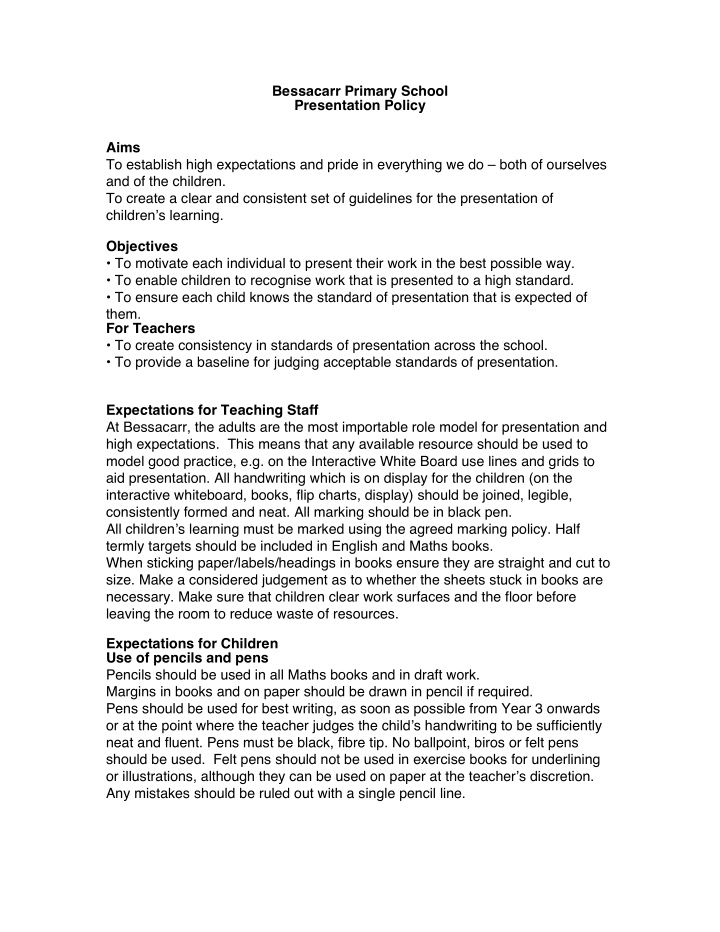



Bessacarr Primary School Presentation Policy Aims To establish high expectations and pride in everything we do – both of ourselves and of the children. To create a clear and consistent set of guidelines for the presentation of children’s learning. Objectives • To motivate each individual to present their work in the best possible way. • To enable children to recognise work that is presented to a high standard. • To ensure each child knows the standard of presentation that is expected of them. For Teachers • To create consistency in standards of presentation across the school. • To provide a baseline for judging acceptable standards of presentation. Expectations for Teaching Staff At Bessacarr, the adults are the most importable role model for presentation and high expectations. This means that any available resource should be used to model good practice, e.g. on the Interactive White Board use lines and grids to aid presentation. All handwriting which is on display for the children (on the interactive whiteboard, books, flip charts, display) should be joined, legible, consistently formed and neat. All marking should be in black pen. All children’s learning must be marked using the agreed marking policy. Half termly targets should be included in English and Maths books. When sticking paper/labels/headings in books ensure they are straight and cut to size. Make a considered judgement as to whether the sheets stuck in books are necessary. Make sure that children clear work surfaces and the floor before leaving the room to reduce waste of resources. Expectations for Children Use of pencils and pens Pencils should be used in all Maths books and in draft work. Margins in books and on paper should be drawn in pencil if required. Pens should be used for best writing, as soon as possible from Year 3 onwards or at the point where the teacher judges the child’s handwriting to be sufficiently neat and fluent. Pens must be black, fibre tip. No ballpoint, biros or felt pens should be used. Felt pens should not be used in exercise books for underlining or illustrations, although they can be used on paper at the teacher’s discretion. Any mistakes should be ruled out with a single pencil line.
Expectations for Handwriting Penpals is the agreed scheme for teaching handwriting. Handwriting is taught for 5 minutes per day and is applied across the curriculum. Any displayed writing should be presented on plain A4, with the handwriting side of the line guide used (double lines). Black pen should be used from Y3 upwards, otherwise pencil. Displayed learning should not be marked. Expectations for Layout • The date is written at the top on the right; the Learning Objective (where appropriate) on the next line on the left against the margin. • The date and Learning Objective must be underlined using a ruler. • At the start of a new piece of work, miss a line under the last piece of work, rule off and start on a new line. Don’t leave a blank page. • Miss a line under the LO and start at the margin. • Leave one line between each paragraph. • If you make a mistake, draw one neat line through the mistake and start again –do not over-write. • Write ON THE LINE. Do not write in the margin. Layout in Mathematics • Each page must have a margin 2 squares wide and drawn on the left hand side. • If appropriate pages can be divided in to two with a ruled line and a margin of 2 squares to the right of it. • The previous piece of work should be ruled off with the date written in figures on the line below. • The date and the LO should be underlined. • All figures must be written neatly and clearly with one figure to each square. • Each calculation must be clearly numbered with the number in the margin to distinguish it from working figures. There should be at least one clear square between each calculation, both horizontally and vertically. • For solving word problems the actual sum should be set out. The answer should be written in a sentence where it clarifies a complex problem or where the focus is on maths vocabulary. • Calculations which involve ‘carrying’ should see the relevant digit written smaller than usual beneath the bottom line. Classroom Organisation and Resources • All tables should have containers with the appropriate equipment: rulers, pens, pencils, colouring pencils. • Each room has whiteboards available for all the children. • Children and staff should check the floor and other surfaces before leaving the room eg at break time for spare equipment.
Outcomes of Presentation Policy Children of all abilities are able to present their work to the highest possible standard increasing their confidence and self-esteem. There is consistency across the school in terms of the standard of presentation expected. Progression in presenting work between each class is evident and understood by all children and adults. Monitoring of Presentation Policy The Senior Leadership Team collect examples of children’s learning on a half- termly basis to ensure that the policy is being implemented consistently. This ensures that the policy leads to good practice in facilitating effective feedback, learning and teaching. Policy Agreed March 2015 Policy Reviewed September 2015
Recommend
More recommend